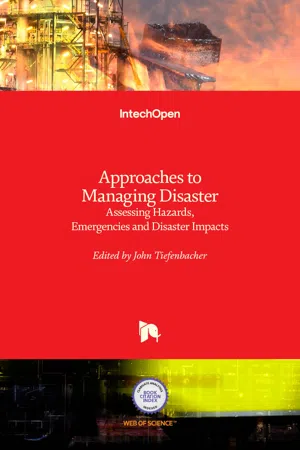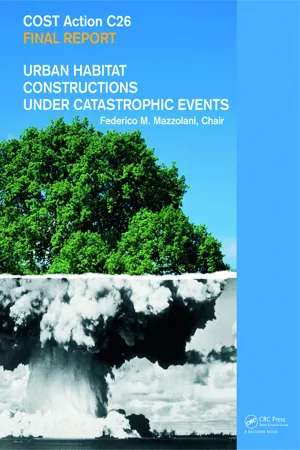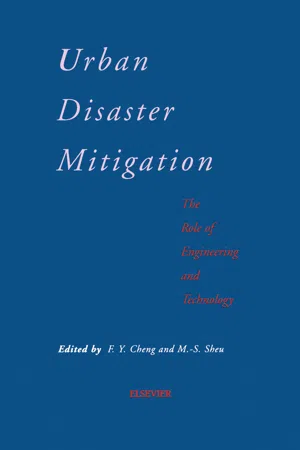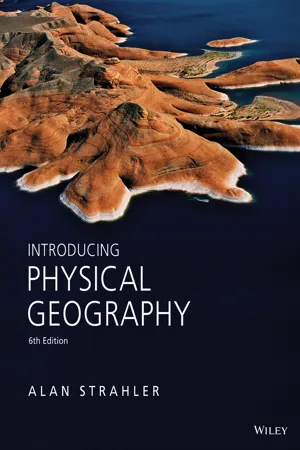Geography
Impacts of Hazards
The impacts of hazards refer to the effects that natural or human-induced disasters have on people, the environment, and infrastructure. These impacts can include loss of life, damage to property, disruption of essential services, and long-term social and economic consequences. Understanding and mitigating these impacts is crucial for effective disaster management and resilience building.
Written by Perlego with AI-assistance
Related key terms
1 of 5
9 Key excerpts on "Impacts of Hazards"
- eBook - PDF
Jostling Between “Mere Talk” and Blame G
Beyond Africa�s Poverty and Underdevelopment Game Talk
- Munyaradzi Mawere(Author)
- 2018(Publication Date)
- Langaa RPCIG(Publisher)
Disasters and natural hazards in Africa Hazards can be defined as natural events which pose threat to the natural environment and human population who are part of the environment. They can be divided into natural and anthropogenic hazards. Understanding the severity of hazards is usually essential for risk analysis and planning for resilience-building as there is evidence of the linkages between hazards and the resilience of rural communities. Additionally, understanding the spatial distribution of the effect of hazards unravels part of the reasons why communities and households need to build resilience. While disaster can be a serious disruption of the functioning of the community or society, it essentially involves widespread human, material, economic or environmental losses and impacts that exceed the ability of the affected community or society to cope using its own [available] resources. Disasters are often described as a result of the combination of exposure to natural hazards, vulnerability of the resident human population and insufficient capacity or measures to reduce or cope with the potential negative consequences. Disaster impacts may include loss of life, injury, disease and other negative effects on human physical, mental and social wellbeing, together with damage to property, destruction of assets, loss of services social and economic disruption and environmental degradation (Oxfam, 2007). Disaster risk reduction refers to the conceptual framework of elements considered with the possibilities to minimise vulnerabilities and disaster risks throughout a society, to avoid (prevention) or to limit (mitigation and preparedness) the adverse Impacts of Hazards, within the broad context of sustainable development. 174 Lopez (2008) states that, disaster risk management includes both disaster risk reduction (prevention, preparedness and mitigation) and humanitarian and development action (emergency response, relief and reconstruction). - eBook - PDF
Geomorphology and Natural Hazards
Proceedings of the 25th Binghamton Symposium in Geomorphology, Held September 24-25, 1994 at SUNY, Binghamton, USA
- M. Morisawa(Author)
- 2013(Publication Date)
- Elsevier Science(Publisher)
Some of these other hazards have been recently reviewed (e.g. Sherman and Nordstrom, 1994), whereas others, such as glacial movement or periglacial effects, are limited in their effect on human populations, or have received little attention as hazards. We have chosen to place geomorphology within the context of the original natural hazards paradigm (White, 1974a) for ease of discussion. We recognize the importance of socio-economic factors in creating hazardous conditions and point to this as an important area of future research. Ultimately, resolution of natural hazards problems must incorporate economics and society, and geomorphologists must be able to recog-nize how the natural systems are affected by human systems. In accordance with the first two goals of the natural hazards paradigm (White, 1974a), we contend that the physical aspects of a hazard event can be evaluated in terms of 5 components: (1) the dynamics of the phys-ical processes; (2) the prediction of the occurrence; (3) the determination of the spatial and temporal char-acteristics; (4) an understanding of the impact of phys-ical characteristics on people's perception; and (5) knowledge about how the physical aspects can be used to formulate adjustments to the event. 4.1. Soil erosion by water Unlike many natural disasters, there is no direct loss of life as a result of soil erosion, but it has a widespread distribution, high remediation costs, a potential for soil deterioration, and reduced food production. Evans (1990) shows that 36% of arable soils in England and Wales are at risk from moderate- to very high-erosion. An evaluation of costs associated with soil erosion in southern Ontario, Canada (Table 2) shows the degree to which the problem impinges on the human system. According to Wall and Dickinson (1978), total cost approached US$ 95 million in 1976; using the con-sumer price index, this cost is equivalent to about US$ 250 million in 1994 dollars. - eBook - PDF
Encyclopedia of Environmental Science Vol1
Ecological Concepts and Environmental Science
- Shalinee Naidoo(Author)
- 2019(Publication Date)
- Delve Publishing(Publisher)
Ecological Concepts and Environmental Science 15 Devices to control water pollution Physics Chemistry Engineering History of water pollution and related di-sasters History Economic impacts of water pollution Economics Demography Sociological impacts of water pollution Sociology Conservation of resources and pollution control Physical science Political science Global warming Expanded into almost all subjects 7.0. ENVIRONMENTAL IMPACTS ON WATER, AIR, AND LAND 7.1. NATURAL HAZARDS AND IMPACTS A natural hazard is defined as a threat from a naturally occurring event that has been taking place throughout history. This event will have a negative effect on humans and the surrounding environment and is commonly referred to as a natural disaster. A natural hazard grows into a natural disaster when extreme events lead to significant harm of surrounding societies such that their ability to respond to the detrimental effects is hampered. Natural hazards can be classified into several categories (Table 2). These natural hazards and related disasters occur as a result of a range of geological processes that are known to have a negative effect on humans (Table 2). Table 2: Classification of Various Types of Natural Hazards Type of hazard Driving processes Geological These hazards are driven by geological processes such as earthquakes and volcanic eruptions Meteorological These hazards are driven by meteorological processes such as those relating to temperature and win d Ecological Concepts and Environmental Science 16 Hydrological These hazards are driven by hydrological processes such as floods, droughts, mudslides, and tsunami s Biological These hazards are driven by biological processes such as various types of infectious diseases that can spread from person to person 7.1.1. Earthquakes An earthquake is a natural phenomenon that is caused by the constant motion of the Earth’s surface. - Jonathan Rougier, Steve Sparks, Lisa J. Hill(Authors)
- 2013(Publication Date)
- Cambridge University Press(Publisher)
In a globalised world the effects of natural disasters are no longer largely confined to within national borders. Complicated and sometimes unforeseen and unexpected interactions take place to cause effects across borders and around the world. Flights are cancelled in Japan because of ash from Iceland. Nuclear power is questioned and re-appraised in Europe due to an earthquake in Japan. Production at the Honda car factory in the UK is compromised due Impacts on technological facilities and infrastructure 473 to lack of critical components caused by floods in Thailand. Stock markets and national economies are tangibly affected by the bigger events. Radioactive waste programmes for geological disposal around the world are inhibited at least in part by a lack of trust that citizens have in the ability of scientists to see into the future and be reassured that natural hazards won’t cause a catastrophe. Responding to the emergent phenomena of impacts from natural hazards on technological and critical infrastructural is a major challenge. Perhaps the first admission must be that so far the response has been inadequate and arguably simply not good enough. Too many hazard and risk assessments are based on narrow, deterministic approaches, which com- monly fail to anticipate extremes and to take full account of the complexity of the systems. We believe that the only way forward is through robust systematic hazard and risk assess- ment that is probabilistic in character and includes quantitatively as far as possible an analysis of uncertainty. Such analysis must begin with an objective identification of facilities and systems that are at risk, together with evaluation of how those risks could manifest themselves (for example, using event trees to look at how systematic failure scenarios might develop at a high level).- eBook - PDF
Approaches to Managing Disaster
Assessing Hazards, Emergencies and Disaster Impacts
- John Tiefenbacher(Author)
- 2012(Publication Date)
- IntechOpen(Publisher)
6 The Impact of Natural Disasters: Simplified Procedures and Open Problems Olga Petrucci CNR-IRPI, Cosenza Italy 1. Introduction A natural hazard is a geophysical, atmospheric or hydrological event (e.g., earthquake, landslide, tsunami, windstorm, flood or drought) that has the potential to cause harm or loss, while a natural disaster is the occurrence of an extreme hazardous event that impacts on communities causing damage, disruption and casualties, and leaving the affected communities unable to function normally without outside assistance (Twig, 2007). The definition of natural disaster impact (NDI) can change according to both the aim of the study and the scientist assessing it. It can be defined as constituting the direct, indirect and intangible losses caused on environment and society by a natural disaster (Swiss Re, 1998). Direct losses include physical effects such as destruction and changes that reduce the functionality of an individual or structure. Damages to people (death/injury), buildings, their contents, and vehicles are included, as are clean-up and disposal costs. Indirect losses affect society by disrupting or damaging utility services and local businesses. Loss of revenue; increase in cost; expenses connected to the provision of assistance, lodging, and drinking water; and costs associated with the need to drive longer distances because of blocked roads are included. Intangible losses include psychological impairments caused by both direct and intangible losses that individuals personally suffer during the disaster. The Natural Disaster Impact Assessment (NDIA) is crucial in helping individuals to estimate replacement costs and to conduct cost-benefit analyses in allotting resources to prevent and mitigate the consequences of damage (UNEP-ECLAC, 2000). A general NDIA procedure has not yet been developed; several approaches are available in literature and their applicability depends on the accessibility of damage data. - eBook - PDF
- Stefano Campus, Secondo Barbero, Stefano Bovo, Ferruccio Forlati(Authors)
- 2007(Publication Date)
- CRC Press(Publisher)
4 Introduction to the Concept of Hazard and Risk This volume deals only with natural dangers, and more specifically with geological, hydrological, and meteorological dangers, which are the specific fields to which Arpa Piemonte dedicates its structures and services, even though other natural and technological hazards also have a considerable impact on human activity. Disasters caused by natural phenomena constitute an enormous obstacle to development in indus- trialised society. It can certainly not be said that calamities did not exist in the past, but the probability of one occurring are now higher than ever and involve increasingly extensive areas of the environment in which we live. The hypothesis of repeated calamitous events, which is now univer- sally accepted, results in the outlining of the cycle of activities related to their management in four phases. These four phases, after the passing of the emergency stage itself, can be defined as: recovery, mitigation, preparation, and response (Figure 1.1.1). After the event Recovery Response Preparation Reconstruction Quiescence Restoration Emergency Pre-impact Mitigation Before the event Impact Figure 1.1.1 The cycle of disaster (from Alexander, 2002). Recovery is the reconstruction phase, which may continue for many years. The mitigation phase includes all the actions planned to reduce the impact of future events (structural and non-structural measures). Prepar- ation refers to actions that reduce the impact when events that potentially causing risks are imminent and include safety measures like evacuation. Forecasting, Hazard, and Risks Related to Natural Phenomena 5 Response is the actuation of procedures during the event or immediately following it, with the main purpose of saving human lives. - eBook - PDF
Urban Habitat Constructions Under Catastrophic Events
COST C26 Action Final Report
- Federico M. Mazzolani(Author)
- 2010(Publication Date)
- CRC Press(Publisher)
Urban Habitat Constructions under Catastrophic Events (Final Report) – Mazzolani (Ed). © 2010 Taylor & Francis Group, London, ISBN 978-0-415-60686-8 2.4 Consequences of natural disasters on constructions Carlos Coelho Civil Engineering Department, University of Aveiro, Portugal Ruben Paul Borg Faculty for the Built Environment, University of Malta, Malta Vlatko Sesov University of Skopye, Macedonia Maurizio Indirli ENEA, Bologna, Italy 2.4.1 INTRODUCTION Most of the highly populated cities all over the world, (but also a large amount of little towns and villages) are prone to natural hazards. Natural hazards are defined as processes, occurring in the biosphere that may constitute a damaging event. The main hazardous catastrophes are earthquakes, volcanic eruptions, landslides, tsunamis, coastal erosions, floods, hurricanes, drought, etc. With regards urban areas, both wild and man-induced fires can be also considered. Consequently, the disaster risk DR (probability of harmful consequences, expected loss of lives, people injured, property, livelihoods, economic activity disrupted, environment damaged, etc., see Figure 1) results from the combination between hazard H, vulnerability V (human condition or process resulting from physical, social, economic and environmental factors, determining probability and scale of damage from the impact of a given hazard) and physical exposure E (elements at risk, an inventory of those people or artifacts exposed to hazards), divided by the RM factor (Risk Management). The Risk Assessment (RA) is an estimate of the social and economic impact that hazards can have on people, buildings, services, facilities and infrastructures. It is worth noting that, in absolute terms (UNPD 2002, Munich Re Group, 2004) the economic cost of disasters has been increasing over the decades (Figure 2). - F.Y. Cheng, M.-S. Sheu(Authors)
- 1995(Publication Date)
- Pergamon(Publisher)
By contrast, the slightly larger (7.1) magnitude Loma Prieta earthquake in the San Francisco Bay area killed only 62 people, injured 3,800, and left approximately 12,000 homeless. The relationship between the physical event and social damage it produces is quite tenuous (Dynes, 1992). For this reason, social scientists define hazards and disasters not on their physical characteristics but on the basis of social disruption. A hazard can be defined as: some aspect of the physical environment that threatens the well-being of individuals and their society. These threats to well-being include harmful or disruptive effects to social, economic, and political systems, or to the built environment (buildings, dams, power and water systems, bridges and roads) that interferes with normal, daily life of a comnaunity. A hazard, then, only exists when it is capable of creating a disaster. A disaster can be said to occur only when the built and social environments are so disrupted that the resources of the social system are overwhelmed and the system is unable to meet the demands placed on it for goods and services that are routinely expected by its citizens. ''~ I This definition is adapted from the classic definition developed by Charles Fritz (1961: 655). Social Science Approachesin Disaster Research A CATEGORIZATION OF RESEARCH EFFORTS Figure 1 presents a method for categorizing different research efforts on two different dimensions: (1) by disaster phases; and by (2) the unit of analysis of the study. 2 305 UNITS OF ANALYSIS DISASTER PHASES Preparedness Mitigation Response Recovery Individuals Groups/ Organizations Organizational Networks/ Communities Regions/ Societies Fig. 1. Typological Scheme For Categorizing Research Topics on Earthquake Hazards Disaster Phases Four phases of disaster-related activities have been used by emergency management specialists to develop hazard reduction and disaster response plans.- eBook - PDF
- Alan H. Strahler(Author)
- 2013(Publication Date)
- Wiley(Publisher)
Environmental Environmental change is produced by both natural and human processes. Human activities are currently changing both the Earth’s climate and the global flows of carbon from land to ocean to atmosphere. Tools in Physical Geography 15 pollution degrades habitat quality for plants and animals, as well as humans. Extreme weather events, which will become more frequent as a result of human- induced climate change, as well as other rare natural events, are increasingly destructive to our expanding human population. POLLUTION As we all know, unchecked human activity can degrade environmental quality. In addition to releasing CO 2 , fuel burning can yield hazardous gases that react to form toxic compounds such as ozone and nitric acid in photochemical smog. Water pollution from fertil- izer runoff, toxic wastes of industrial production, and acid mine drainage can severely degrade water quality. This degradation impacts not only the ecosystems of streams and rivers, but also the human populations that depend on rivers and streams as sources of water supply. Groundwater reservoirs can also be polluted or turn salty in coastal zones when drawn down excessively. Environmental pollution, its causes, its effects, and the technologies used to reduce pollution, comprise a subject in its own right. As a text in physical geography that emphasizes the natural processes of the Earth’s land surface, we touch on air and water pollution in two chapters: Chapter 4 for air pollution and Chapter 14 for surface water pollution, irrigation effects, and ground- water contamination. EXTREME EVENTS Catastrophic events—floods, fires, hurricanes, earth- quakes, and the like—can have great and long-lasting impacts on both human and natural systems. Are human activities increasing the frequency of these extreme events? As our planet warms in response to changes in the greenhouse effect, global climate modelers predict that weather extremes will become more severe and more frequent.
Index pages curate the most relevant extracts from our library of academic textbooks. They’ve been created using an in-house natural language model (NLM), each adding context and meaning to key research topics.








